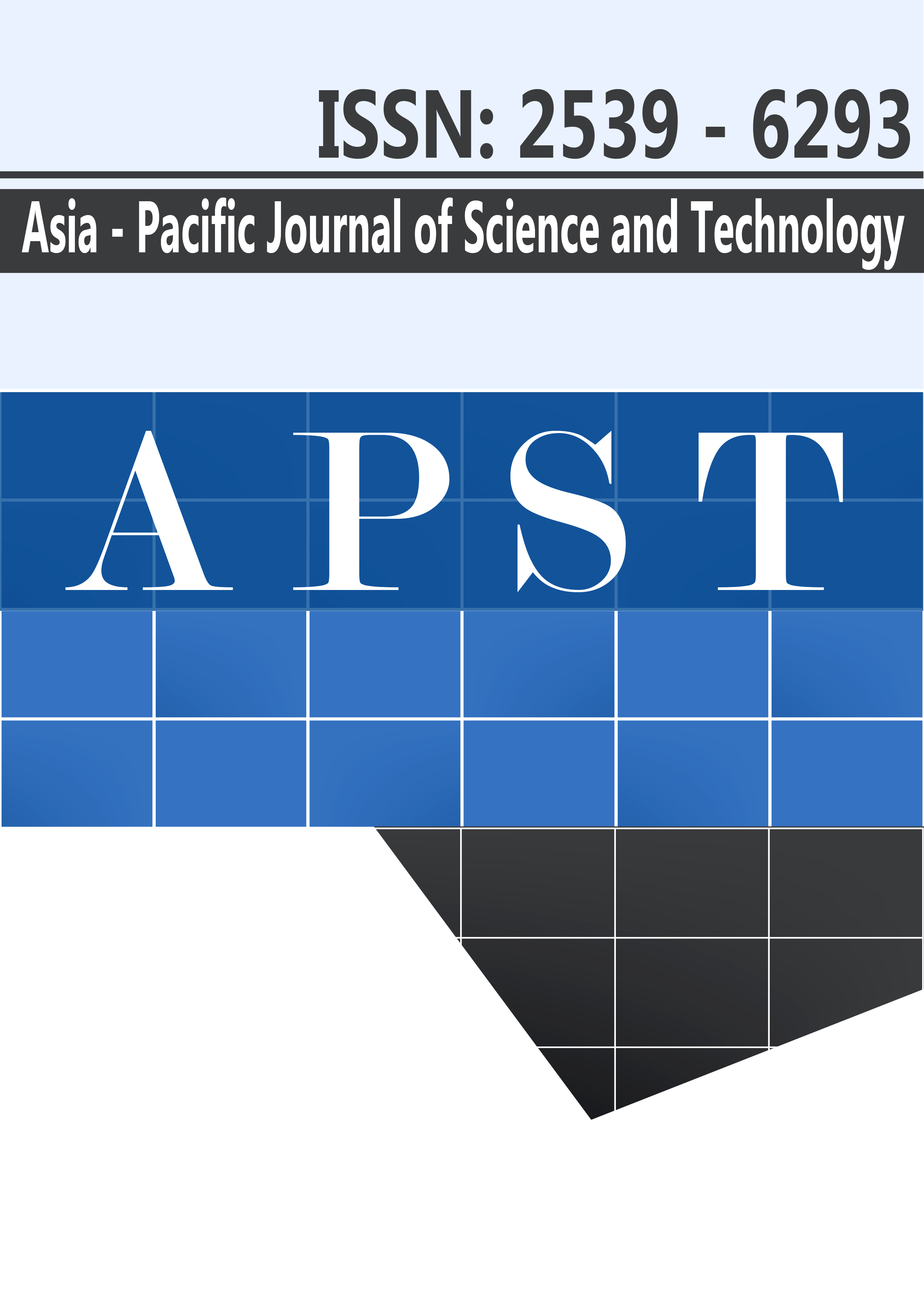Characterization of exopolysaccharide (EPS) from Lactobacillus fermentum (TISTR 2514) and its potential prebiotic properties
Main Article Content
Abstract
The aims of this study were to characterize and investigate the prebiotic potential of exopolysaccharides (EPS) produced by Lactobacillus fermentum TISTR2514 from Thai-fermented food. The EPS showed a symmetrical sharp peak which separated using GPC technique and its molecular weight was 48.192 kDa. HPLC analyses presented that the EPS consisted of rhamnose, galactose, mannose and glucose. The prebiotic potential of EPS produced by L. fermentum TISTR2514 was studied. The results indicated that EPS can be resisted to artificial gastric juice at pH1 for 2h and to -amylase at pH7 for 6h, in the percent of more than 89 and 82%, respectively. Furthermore, these EPS could stimulate the growth of probiotics (L.rhamnosus DSM 20021 and L. casei DSM 20011 from log 6.02 0.08 to log 8.08 0.06 CFU/ml and from log 6.030.05 CFU/ml to log 8.170.02 in 24h, respectively), which was higher than using FOS. Bacterial enzyme assessment of a combination of probiotics and EPS-producing strain L. fermentum TISTR2514 (candidate prebiotic) revealed a greater reduction in -glucuronidase activity than using probiotics or EPS alone. The ability of synbiotic (probiotics and EPS) is particularly interesting for potentially reducing the-glucuronidase activity and for decreasing the risk of colorectal cancer, however further in-depth study is required.
Article Details
References
from lactic acid bacteria. Biotechnol Adv. 2001;19:597-625.
[2] Harutoshi T. Exopolysaccharides of Lactic Acid Bacteria for Food and Colon Health, Applications. Lactic
Acid Bacteria – Intech. 2013;515-38.
[3] Patel S, Goyal A. The current trends and future perspectives of prebiotics research: a review. 3 Biotech.
2012;15:115–25.
[4] Fooks LJ, Gibson GR. Probiotics as modulators of the gut flora. Br J Nutr. 2002;88:39-49.
[5] Grosu-Tudor SS, Zamfir M, Meulen RVD, Falony G, Vuyst LD. Prebiotic potential of some
exopolysaccharides produced by lactic acid bacteria. Rom Biotechnol Lett. 2003;18:8666-76.
[6] Compare D, Nardone G. The bacteria-hypothesis of colorectal cancer: pathogenetic and therapeutic
implication. Transl Gastrointest Cancer. 2014;3: 44-53.
[7] Gao Z, Guo B, Gao R, Zhu Q, Qin H. Microbiota disbiosis is associated with colorectal cancer. Front
Microbiol 2015;6: 1-9.
[8] Cipe G, Idiz UO, Firat D, Bektasoglu H. Relationship between intestinal microbiota and colorectal cancer.
World J Gastrointest Oncol. 2005;7:233-40.
[9] Larsson SC, Wolk A. Meat consumption and risk of colorectal cancer: a meta-analysis of prospective
studies. Int J Cancer. 2006;119:2657-64.
[10] Goldin BR, Gorbach SL. The relationship between diet and rat fecal bacterial enzymes implicated in colon
cancer. J Natl Cancer Inst. 1976;57:371-75.
[11] Goldin BR, Gorbach SL. Effect of Lactobacillus acidophilus dietary supplementation on 1, 2-
dimethylhydrazine dihydrochloride-induced intestinal cancer in rats. J Natl Cancer Inst. 1980;64:263-5.
[12] Ling WH, Korpela R, Mykkanen H, Salminen S, Hannine O. Lactobacillus strains GG supplementation
decreases colonic hydrolytic and reductive enzyme activities in healthy female adults. J Nutr. 1994;124:18-
23.
[13] Gibson GR, Roberfroid MB. Dietary modulation of the human colonic microbiota: Introducing the concept
of prebiotics. J Nutr. 1994;125:1401-12.
[14] Das D, Baruah R, Goyal A. A food additive with properties of an -D-glucan from Lactobacillus
plantarum DM5. Int J Biol Macromol. 2014;69: 20-6.
[15] Jolly L, Vincent SJ, Duboc P, Neeser JR. Exploiting exopolysaccharides from lactic acid bacteria. Antonie
Van Leeuwenhoek. 2002;82:367–74.
[16] Monsan P, Bozonnet S, Albenne C, Joucla G, Willemot R, Remaud-Simeson M. Homopolysaccharides
from lactic acid bacteria. Int Dairy J. 2001;11:675–85.
[17] Dubois M, Gilles KA, Hamilton JK, Rebers PA, Smith F. Colorimetric Method for Determination of
sugars and Related Substances. Anal Chem. 1956;28:350-6.
[18] Nelson N. A photometric adaptation of the Somogyi method for the determination of glucose. J Biol Chem. 1944;153:375-80. [19] Somogyi M. A new reagent for the determination of sugar. J Biol Chem. 1945;160:61-8.
[20] Korakli M, Ganzle MG, Vogel RF. Metabolism by bifidobacteria and lactic acid bacteria of polysaccharides from wheat and rye, and exopolysaccharides produced by Lactobacillus sanfranciscensis. J Appl Microbiol. 2002;92:958-65.
[21] Wichienchot S, Jatupornpipat M, Rastall RA. Oligosaccharides of pitaya (dragon fruit) flesh and their prebiotic properties. Food Chem. 2010;120:850-57.
[22] Wang X, Huang M, Sun FYH, Zhou X, GuoY, Wang X, et al. Rapeseed polysaccharides as prebiotics on growth and acidifying activity of probiotics in vitro. Carbohydr Polym. 2015;125:232-40.
[23] Rowland IR, Rumney CJ, Coutts JT, Lievense LC. Effect of Bifidobacterium longum and inulin on gut bacterial metabolism and carcinogen-induced aberrant crypt foci in rat. Carcinogenesis. 1998;19:281-5.
[24] Roller M, Femia PA, Caderni G, Rechkemmer G, Watzl B. Intestinal immunity of rats with colon cancer is modulated by oligofructose-enriched inulin combined with Lactobacillus rhamnosus and Bifidobacterium lactis. Br J Nutr. 2014;92:931-8.
[25] Hughes R, Rowland IR. Stimulation of apoptosis by two prebiotic chicoryfructans in the rat colon. Carcinogenesis. 2001;22:43-7.
[26] Ramirez-Farias C, Slezak K, Fuller Z, Duncan A, Holtrop G, Louis P. Effect of inulin on the human gut micribiota: stimulation of Bifidobacterium adolescentis and Faecalibacterium prausnitzii. Br J Nutr. 2008;101:541-50.
[27] Saulnier DMA, Gibson GR, Kolida S. In vitro effects of selected synbiotic on the human feacal microbiota consumption. FEMS Microbiol Ecol. 2008;66:516-27.
[28] Bamba A, Nemcova R, Gancarcikova S, Herich R, Guba P, Mudronova D. Improvement of the probiotic effect of micro-organisms by their combination with maltodextrins, fructo-oligosaccharides and polyunsaturated fatty acids. Br J Nutr. 2002;88:S95-9.


